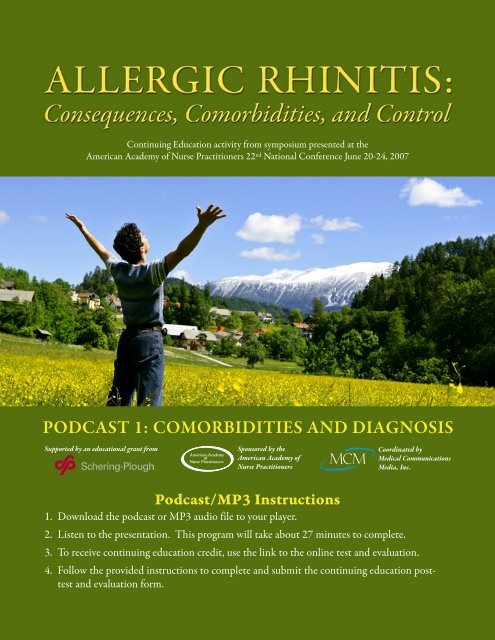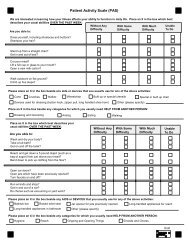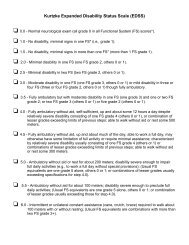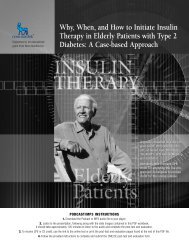PODCAST 1: COMORBIDITIES AND DIAGNOSIS - CMEcorner.com
PODCAST 1: COMORBIDITIES AND DIAGNOSIS - CMEcorner.com
PODCAST 1: COMORBIDITIES AND DIAGNOSIS - CMEcorner.com
Create successful ePaper yourself
Turn your PDF publications into a flip-book with our unique Google optimized e-Paper software.
Continuing Education activity from symposium presented at the<br />
American Academy of Nurse Practitioners 22 nd National Conference June 20-24, 2007<br />
<strong>PODCAST</strong> 1: <strong>COMORBIDITIES</strong> <strong>AND</strong> <strong>DIAGNOSIS</strong><br />
Supported by an educational grant from<br />
Sponsored by the<br />
American Academy of<br />
Nurse Practitioners<br />
Coordinated by<br />
Medical Communications<br />
Media, Inc.<br />
Podcast/MP3 Instructions<br />
1. Download the podcast or MP3 audio file to your player.<br />
2. Listen to the presentation. This program will take about 27 minutes to <strong>com</strong>plete.<br />
3. To receive continuing education credit, use the link to the online test and evaluation.<br />
4. Follow the provided instructions to <strong>com</strong>plete and submit the continuing education posttest<br />
and evaluation form.
<strong>PODCAST</strong> 1: <strong>COMORBIDITIES</strong> <strong>AND</strong> <strong>DIAGNOSIS</strong><br />
Program Overview<br />
Up to 40% of Americans suffer from some form of allergic rhinitis, a syndrome often characterized by a<br />
collection of symptoms that include sneezing, nasal congestion, nasal itching, and rhinorrhea. When poorly<br />
controlled, the condition is often associated with other <strong>com</strong>orbidities, such as asthma and sinusitis. Allergic<br />
rhinitis and its <strong>com</strong>orbidities significantly affect the quality of life in those affected by restricting the patient's<br />
daily activities. This results in a decrease in performance and productivity while at school or work and an<br />
increase in absenteeism. In this presentation, faculty discusses the impact that allergic rhinitis and its<br />
<strong>com</strong>orbidities have on patients' health and well-being. Because accurate diagnosis of rhinitis directs treatment,<br />
the patient history and physical examination also are reviewed.<br />
Target Audience<br />
This program is designed for nurse practitioners caring for patients with allergic rhinitis.<br />
Program Learning Objectives<br />
At the end of this program, the participant should be able to:<br />
1. Discuss the prevalence of allergic rhinitis.<br />
2. Describe the quality of life issues associated with rhinitis in children and adults.<br />
3. Identify the classic symptoms of rhinitis.<br />
4. Describe the key areas of the history and physical exam when working up a patient with possible<br />
allergic rhinitis.<br />
Accreditation Statement<br />
This program is approved for .5 contact hour of continuing education by the American Academy of Nurse<br />
Practitioners. Program ID #: 0709436.<br />
Release Date: 11/1/07 • Expiration Date: 11/1/08<br />
© 2007 American Academy of Nurse Practitioners<br />
Disclaimer<br />
None of the contents may be reproduced in any form without prior written permission from the publisher. The opinions expressed in this activity are those of the speakers and do not necessarily reflect the opinions or<br />
re<strong>com</strong>mendations of their affiliated institutions, the publisher, the American Academy of Nurse Practitioners, or Schering Plough. Any medications or other diagnostic or treatment procedures discussed by the program<br />
speakers should not be utilized by clinicians without evaluation of their patients’ conditions and possible contraindications or risks, and without a review of any applicable manufacturer’s product information and<br />
<strong>com</strong>parison with the re<strong>com</strong>mendations of other authorities.
Faculty<br />
Todd A. Mahr, MD<br />
Director, Pediatric Allergy • Gundersen Lutheran Medical Center<br />
Clinical Professor • Department of Pediatrics • University of Wisconsin School of Medicine<br />
Dr. Mahr is a clinical professor in the Department of Pediatrics at the University of Wisconsin School<br />
of Medicine and Public Health. He also serves as Director of Pediatric Allergy at the Gundersen<br />
Lutheran Medical Center, La Crosse, Wisconsin. A published author of numerous peer-reviewed<br />
articles and book chapters, Mahr lectures nationally and internationally on various allergy related<br />
topics. He is board certified in pediatrics and allergy/immunology.<br />
Mary Lou Hayden, RN, MS, FNP-C, AE-C<br />
Clinical Assistant Professor • University of Virginia • Asthma and Allergy Nurse Practitioner<br />
Virginia Adult and Pediatric Allergy and Asthma • Richmond, Virginia<br />
Mary Lou Hayden has been a nurse practitioner in asthma and allergy for 25 years. A member of the<br />
American Academy of Allergy and Immunology, she co-chaired the Allied Health Committee and the<br />
Research Sub<strong>com</strong>mittee and received the 2004 Allied Health Recognition Award. She is also active in<br />
the Allied Health Program of the American College of Allergy, Asthma and Immunology. A certified<br />
asthma educator, she serves on the Board of Directors of the Association of Asthma Educators. She is<br />
a frequent speaker on the topics of allergic rhinitis ·and asthma and has authored numerous articles for<br />
patients and health care professionals. Mary Lou earned her Bachelors in Nursing from Stanford and<br />
her Masters from the University of Rochester, School of Nursing.<br />
AANP Disclosure Statement and Faculty Disclosures<br />
It is AANP's goal to ensure balance, independence, objectivity, and scientific rigor in all its educational activities. To meet this goal, both<br />
real and/or potential conflicts of interest must be considered during the development of a continuing educational activity. All individuals<br />
having control over the development of an activity’s content and all faculties participating in AANP programs are expected to disclose<br />
any relationships they may have with <strong>com</strong>mercial <strong>com</strong>panies whose products or services may be mentioned. Potential learners will be<br />
informed of all disclosed relationships. The following are all disclosures for this CE program:<br />
Mary Lou Hayden, RN, MS, FNP, APRN, AE-C discloses that she is a member of speakers' bureaus for Schering-Plough, Genentech,<br />
and AstraZeneca, and advisory <strong>com</strong>mittees for Genentech, sanofi-aventis, and AstraZeneca.<br />
Todd A. Mahr, MD discloses that he has received honoraria, consultant fees, and research support, and is a member of speakers' bureaus<br />
for GlaxoSmithKline, Alcon Laboratories, Genentech, Merck, Novartis, Schering-Plough, sanofi-aventis, and Verus Pharmaceuticals.<br />
Disclosure of Unlabeled Use<br />
This educational activity may contain discussion of published and/or investigational uses of agents for the treatment of allergic rhinitis.<br />
The FDA may not have approved some uses of these agents. Please refer to the official prescribing information for each product for<br />
discussion of approved indications, contraindications, and warnings.
<strong>PODCAST</strong> 1: <strong>COMORBIDITIES</strong> <strong>AND</strong> <strong>DIAGNOSIS</strong><br />
To receive CE credit, an online post-test and evaluation must be <strong>com</strong>pleted. If you successfully answer at least 70%<br />
of these items online, you will be able to print a certificate. The test is located at www.aanp.org/testingcenter.<br />
The following copy of the Post-Test is provided ONLY as a convenience and to help in preparation for<br />
the post-test. Credit will ONLY be awarded for tests <strong>com</strong>pleted online.<br />
Post-Test<br />
1. The third National Health and Nutrition<br />
Examination Survey (NHANES-3) showed that<br />
over _____of those surveyed tested positive for<br />
at least one airborne allergen.<br />
a. 10% b. 30% c. 50% d. 60%<br />
2. The prevalence of allergic rhinitis among children is<br />
up to ____.<br />
a. 10% b. 20% c. 30% d. 40%<br />
3. All of the following are consequences of<br />
allergies except:<br />
a. Restricted activity participation<br />
b. Daytime sleepiness<br />
c. Diminished school/work performance<br />
d. Decreased appetite<br />
4. According to the Allergies in America survey, which<br />
of the following symptoms is most bothersome to<br />
patients with allergic rhinitis<br />
a. Itchy eyes<br />
b. Nasal congestion<br />
c. Runny nose<br />
d. Sneezing<br />
5. Which of the following <strong>com</strong>orbidities is present in<br />
more than 50% of children with allergic rhinitis<br />
a. Recurrent sinusitis<br />
b. Asthma<br />
c. Migraines<br />
d. Otitis media<br />
6. Which of the following is the major mediator of<br />
allergic rhinitis<br />
a. Proteases<br />
b. Bradykinin<br />
c. Histamine<br />
d. Prostaglandins<br />
7. Which of the following is not a cause of vasomotor<br />
rhinitis<br />
a. Viral respiratory infection<br />
b. Topical (nasal) decongestants<br />
c. Dust mites<br />
d. Pregnancy<br />
8. At least ______ of patients with allergic rhinitis have<br />
non-allergic triggers<br />
a. 25%<br />
b. 50%<br />
c. 75%<br />
d. None of the above<br />
9. Which of the following historical information is<br />
helpful in diagnosing allergic rhinitis<br />
a. Family history of allergic rhinitis<br />
b. History of hypertension<br />
c. A and B<br />
d. None of the above<br />
10. Which of the following is helpful in determining if a<br />
patient has allergic rhinitis<br />
a. Allergy skin test<br />
b. RAST test<br />
c. Nasal cytology<br />
d. All of the above







